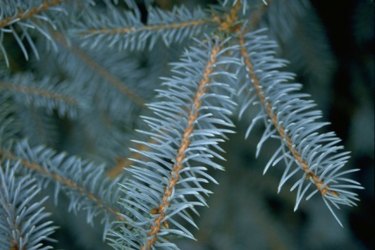
Needle drop naturally occurs seasonally in blue spruce. Some browning and shedding of inner needles is normal in the fall. During most years, the browning and needle drop is hardly noticeable. If the inner needle browning is significant, however, a fungal disease may be the culprit. Cytospora canker and Rhizosphaera needle cast are common causes of inner needle browning in blue spruce.
Diseases
Video of the Day
Cytospora canker is caused by the fungus Cytospora kunzei, which may enter the tree through wounds or branch stubs. Browning of the inner needles on the tree is an early symptom. The brown needles eventually fall off, leaving bare branches. Blue spruce trees are also susceptible to Rhizosphaera needle cast, caused by the fungus Rhizosphaera. The disease begins on the tree's lower branches and works its way upward. Needles turn purple or brown in color and eventually fall off. Occasionally, the disease begins higher in the tree, with inner needles browning in the upper branches.
Video of the Day
Symptoms and Damage
Blue spruces that are infected with Cytospora canker generally have some branch dieback, which often starts on the lower branches of the tree. An examination of the dead branches may reveal the presence of a sticky white sap, which infected trees produce as a defense once infected with Cytospora canker. Eventually the fungus may encircle branches, causing death. With Rhizosphaera needle cast, small black spots, which are the fruiting structures of the fungus, may appear in rows on the needles of the blue spruce. These are visible with the aid of a magnifying glass. Rhiszophaera needle cast can kill a tree within a few years if not treated.
Control
Pruning diseased branches is the main method of treating trees with Cytospora canker. Prune 4 to 6 inches below visible cankers. You may need to cut some branches back to the trunk. Prune during dry weather to prevent spread of the disease, as the fungal spores may spread in wet conditions. While fungicide sprays are not effective for controlling canker disease, they may be useful for controlling Rhizosphaera needle cast. Infected trees should be sprayed with a fungicide during the late spring and early summer. Read the product label for specific rate and timing instructions.
Prevention
The best control for fungal disease is prevention. Plant the tree in a well-drained site that allows for unrestricted growth. Add mulch around the tree to increase overall vigor through moisture retention and weed control. Water the blue spruce deeply during dry conditions to prevent drying out. If you plant many trees, space them to promote good air circulation.